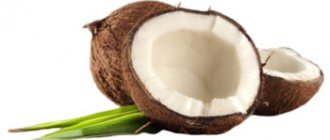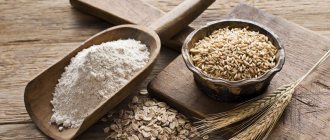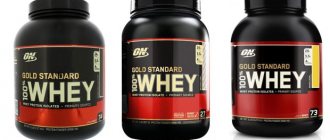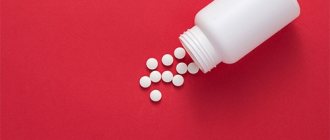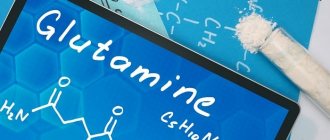© JEGAS_RA — depositphotos.com
Share:
Taurine is a derivative of the amino acid cysteine. This substance is present in small quantities in various tissues, the highest concentration is observed in the myocardium and skeletal muscles, as well as bile.
As a rule, taurine is found in the body in free form: it does not form bonds with other amino acids and does not participate in the construction of protein molecules. This compound is used in medicine, the production of sports nutrition, and energy drinks.
Taurine[edit | edit code]
| What is taurine | |
| Taurine is a non-essential amino acid produced by the body. It is found in meat, fish, eggs and milk. It is the second most abundant acid in muscle tissue. Taurine is sold as a stand-alone supplement, but most often as an ingredient in protein drinks, creatine supplements, and sports drinks. It is suggested to athletes to increase muscle mass and reduce muscle breakdown during intense exercise. | |
| Action of taurine | |
| Taurine affects various body functions, including brain and nervous system function, blood pressure regulation, fat digestion, absorption of fat-soluble vitamins, and blood cholesterol control. It is used as a supplement because it is believed to reduce muscle breakdown during exercise. The theory behind taurine is that it can act like insulin, moving amino acids and sugar from the bloodstream into muscle cells. This could cause an increase in cell volume, thereby increasing protein synthesis and reducing protein breakdown. | |
| Do you need it? | |
| Intense exercise depletes the body's taurine levels, but there is no conclusive research to support the claims of taurine supplements. Since taurine can be obtained from food (animal protein sources), there appears to be no compelling reason to recommend supplementation for athletic performance or muscle building. Taurine is safe in amounts found in protein and creatine sports nutrition supplements. Very high doses of individual supplements may cause toxicity. |
Taurine
- 2-aminoethanesulfonic acid, present in small quantities in the tissues and bile of animals, including humans. Used as a medicine (INN Taurine; Taufon - Taufonum), included in many energy drinks and sports supplements.
The name comes from Lat. taurus (ox), since it was first obtained from ox bile by German scientists Friedrich Tiedemann and Leopold Gmelin.
Pharmacokinetics
In double-blind randomized studies performed on physically healthy 9 men, it was shown that when taking taurine (50 mg/kg), its peak plasma concentration at rest was observed at 89 minutes, and when taken before a one-hour exercise, at 112 minutes[ 1].
The Ekaterinburg branch of the Ural State University of Physical Culture studied the quantitative change in amino acids in the plasma of athletes. It turns out that the average value of taurine in young people not involved in sports is 145.6 µM, in track and field athletes - sprinters - 48.9 µM (p <0.01), in wrestlers the taurine content in the blood was 216.4 µM. The work does not indicate the conditions for blood sampling. High concentrations in weightlifters may reflect very rapid elimination of taurine from intracellular stores and an increase in plasma. Low taurine concentrations in sprinters indicate taurine loss and can lead to arrhythmias [2].
Administration of taurine to experimental animals has demonstrated that this amino acid significantly increases physical endurance and improves performance during treadmill exercise, as measured by changes in the excretion of creatinine, creatine, and 3-methylhistidine. Also, in animals with spinal trauma, the anti-inflammatory effect of taurine (250 mg/kg) was found to reduce the concentration of interlekin-6 and the activity of myeloperoxidase [3](22).
In another experiment, volunteers took taurine for seven days, which led to a 13-fold increase in its plasma concentration; the content in the muscles did not change either at rest or during physical exercise [4].
Taurine and muscle protection from dystrophy
Cell culture studies have shown that taurine eliminates muscle dystrophy caused by dexamethasone[5]. Moreover, the addition of taurine itself to the cell culture did not cause a change in the cell phenotype, i.e., taurine does not have a hypotrophic effect. The question of the mechanism of this action still remains open. Dexamethasone is known to promote muscular dystrophy through the atrogin-1 factor and the enzyme (MAFbx -a muscle-specific ubiquitin ligase)[6]. Taurine did not affect the dexamethasone signal, which is mediated by atrogin-1.
Taurine and tissue regeneration
It was shown in an experiment on mice that those muscles that contained little taurine showed low regenerative ability [7] [8].
The following work [9] demonstrated the protective effect of taurine during physical exercise. The studies were conducted on young people (18-20 years old). The level of oxidative stress was assessed by the production of thiobarbituric acid and DNA damage in white blood cells. Supplementing the diet with taurine for 7 days not only reduced oxidative DNA damage in white blood cells, but also increased exercise tolerance.
Taurine and exercise
Changes in urinary and plasma taurine were assessed in runners competing in the 1998 Rotterdam Marathon immediately after the competition and 24 hours later during the recovery period. The source of the increase in urinary taurine, the researchers suggest, was primarily muscle. Those athletes who did not recover after prolonged exercise had low concentrations of taurine in their urine. The authors propose to evaluate the rehabilitation process using taurine as an indicator of muscle damage[10][11].
In studies by Branth S. and Hambraeus L.[12] et al. studied energy metabolism during long-term seven-hour training in 12 competitive cyclists (6 men and 6 women). Such strenuous training results in significant metabolic stress, particularly an increase in reactive oxygen species. The latter was recorded by an increase in malondialdehyde (MDA). Significantly in parallel with this, glycogen reserves were depleted and cellular edema increased.
Since taurine is the main osmoregulator, its concentration in the extracellular space increased greatly. This loss of taurine by the cell leads to its swelling and a decrease in the availability of glucose, since in parallel with this there is some insulin resistance. The authors believe that taurine may play an important protective role against pathological disturbances in ion concentration, as observed during metabolic cellular stress.
The purpose of the following study was to examine the effects of a single dose of 1000 mg taurine on maximal endurance in runners during a 3-kilometer time trial. Taurine supplementation improved performance by 1.7% (646.6 ± 52.8 s vs. 658.5 ± 58.2 s) (p = 0.013). There was no effect on relative oxygen consumption, heart rate, or blood lactate.
The Ekaterinburg branch of the Ural State University of Physical Culture studied the quantitative change in amino acids in the plasma of athletes. It turns out that the average value of taurine in young people not involved in sports is 145.6 µM, in track and field athletes - sprinters - 48.9 µM (p <0.01), in wrestlers the taurine content in the blood was 216.4 µM. The work does not indicate the conditions for blood sampling. High concentrations in weightlifters may reflect very rapid elimination of taurine from intracellular stores and an increase in plasma. Low taurine concentrations in sprinters indicate taurine loss and can lead to arrhythmias [13].
Administration of taurine to experimental animals has demonstrated that this amino acid significantly increases physical endurance and improves performance during treadmill exercise, as measured by changes in the excretion of creatinine, creatine, and 3-methylhistidine. Also, in animals with spinal trauma, the anti-inflammatory effect of taurine (250 mg/kg) was found to reduce the concentration of interlekin-6 and the activity of myeloperoxidase [14].
Anti-stress effect of taurine
Stress is a normal reaction of the body, but its effect can be destructive if we are talking about overreactions, which often depend on the nervous system of the person himself and on the specific situation. The release of large amounts of adrenaline leads to depletion of energy reserves (fats, glycogen) and damage to internal organs.
Taurine may have some anti-stress effects. Specifically, it reduces stress-induced increases in blood sugar by reducing the production of adrenaline from the adrenal glands. This was demonstrated in 1975 on the brain of rats by Japanese scientists[15]
Russian researchers in 1979 showed that taurine is a nonspecific regulator of the sensitivity of myocardial cells to biologically active drugs [16].
Trauma is also stressful for the body. It leads to a significant loss of taurine and ultimately to a drop in its concentration in the blood plasma by almost half [17].
Impact on the athlete's body
Taurine is recommended for use by athletes under serious strength loads (bodybuilders, crossfitters).
The benefits of this amino acid are the following:
- increased performance, rapid removal of metabolic products (lactic acid), which cause discomfort in the muscles and a feeling of fatigue;
- acceleration of recovery after intense exercise;
- increased transport of glucose to muscles to maintain their tone and growth;
- suppression of convulsive muscle contractions during excessive load, lifting heavy weights;
- increasing the speed of recovery after injuries and surgical interventions;
- protecting the cellular structures that make up the muscle fiber from oxidative stress during intense training;
- accelerating fat burning.
Taurine in sports nutrition[edit | edit code]
In sports nutrition, the same amounts of taurine are added, which suggests that it does not have a significant stimulating effect.
It is believed that taurine prevents obesity[19]. But there is no data that it promotes weight loss.
Taurine has also been found to be essential for normal skeletal muscle function. [20] The study was conducted on mice genetically deficient in taurine. However, supplemental taurine in healthy animals did not produce a statistically significant increase in muscle mass.
Taurine has been proven to help lower blood sugar levels, so it is beneficial for people with diabetes. [21]
How does it work
Being a fairly small molecule, taurine crosses the blood-brain barrier and enters the central nervous system from the blood. There it modulates GABA and glycine receptors .
GABA (gamma-aminobutyric acid) is an inhibitory neurotransmitter that calms the nervous system and also causes an anxiolytic (anti-anxiety) effect. And glycine receptors enhance cognitive functions, elevate mood, increase appetite, and also improve digestion. These receptors also help the body produce serotonin. Serotonin is a hormone/neurotransmitter that is also responsible for mood and sleep.
Together, this reduces excess stimulation (anxiety and stress) while promoting calm relaxation.
Other mechanisms of action:
- Stimulates growth hormone.
- Stabilizes the cell membrane and maintains its structural integrity.
- Improves immune function and creates antibodies.
- Works as a neurotransmitter and helps maintain calcium homeostasis in the brain.
Links[edit | edit code]
- Mero A, Leikas A, Rinkinen N, Huhta P, Hulmi JJ, Pitkänen H, Knuutinen J. Effect of strength training session on plasma amino acid concentration following oral ingestion of arginine or taurine in men. Amino Acids. 2008 Jun;35(1):99-106. Epub 2008 Jan 31.
- Pavlov V.A. Proceedings of Vseros. scientific-practical conf. with international participation: “Health is the basis of human potential: problems and ways to solve them” - St. Petersburg: Polytechnic Publishing House. Univ., 2008, 374 p.
- Nakajima Y, Osuka K, Seki Y, Gupta RC, Hara M, Takayasu M, Wakabayashi T. Taurine reduces inflammatory responses after spinal cord injury. J Neurotrauma. 2009 Oct 15.
- Galloway SD, Talanian JL, Shoveller AK, Heigenhauser GJ, Spriet LL. Seven days of oral taurine supplementation does not increase muscle taurine content or alter substrate metabolism during prolonged exercise in humans. J Appl Physiol. 2008 Jun 26
- Uozumi Yoriko, Ito Takashi, Hoshino Yuki, Mohri Tomomi, Maeda Makiko, Takahashi Kyoko, Fujio Yasushi and Azuma Junichi. Myogenic differentiation induces taurine transporter in association with taurine-mediated cytoprotection in skeletal muscles Biochem. J. (2006) 394, 699–706/
- Bodine, S.C., Latres, E., Baumhueter, S., Lai, V.K., Nunez, L., Clarke, B.A., Poueymirou, W.T., Panaro, F.J., Na, E., Dharmarajan, K. et al. (2001) Identification of ubiquitin ligases required for skeletal muscle atrophy. Science 294, 1704–1708
- De Luca, A., Pierno, S., Liantonio, A., Cetrone, M., Camerino, C., Fraysse, B., Mirabella, M., Servidei, S., Ruegg, UT and Conte Camerino, D. (2003) Enhanced dystrophic progression in mdx mice by exercise and beneficial effects of taurine and insulin-like growth factor-1. J. Pharmacol. Exp. Ther. 304, 453–463
- McIntosh, L.M., Garrett, K.L., Megeney, L., Rudnicki, M.A. and Anderson, J.E. (1998) Regeneration and myogenic cell proliferation correlate with taurine levels in dystrophin and MyoD-deficient muscles. Anat. Rec. 252, 311–324
- Zhang M, Izumi I, Kagamimori S, Sokejima S, Yamagami T, Liu Z, Qi B. Role of taurine supplementation to prevent exercise-induced oxidative stress in healthy young men. Amino Acids. 2004 Mar;26(2):203-7.
- Cuisinier C, Ward RJ, Francaux M, Sturbois X, de Witte P. Changes in plasma and urinary taurine and amino acids in runners immediately and 24h after a marathon. Amino Acids. 2001;20(1):13-23.
- Nanobashvili J, Neumayer C, Fugl A, Punz A, Blumer R, Prager M, Mittlbock M, Gruber H, Polterauer P, Roth E, Malinski T, Huk I. Ischemia/reperfusion injury of skeletal muscle: plasma taurine as a measure of tissue damage. Surgery. 2003 Jan;133(1):91-100.
- Branth S, Hambraeus L, Piehl-Aulin K, Essén-Gustavsson B, Akerfeldt T, Olsson R, Stridsberg M, Ronquist G. Metabolic stress-like condition can be induced by prolonged strenuous exercise in athletes. Ups J Med Sci. 2009;114(1):12-25.
- Pavlov V.A. Proceedings of Vseros. scientific-practical conf. with international participation: “Health is the basis of human potential: problems and ways to solve them” - St. Petersburg: Polytechnic Publishing House. Univ., 2008, 374 p.
- Nakajima Y, Osuka K, Seki Y, Gupta RC, Hara M, Takayasu M, Wakabayashi T. Taurine reduces inflammatory responses after spinal cord injury. J Neurotrauma. 2009 Oct 15.
- Nakagawa K, Kuriyama K. Effect of taurine on alteration in adrenal functions induced by stress. Jpn J Pharmacol. 1975 Dec;25(6):737-46.
- Mal'chikova LS, Speranskaia NV, Elizarova EP. Effect of taurine on cyclic AMP and GMP levels in the hearts of rats exposed to stress. Biull Eksp Biol Med. 1979 Feb;87(2):134-7.
- Jeevanandam Malayappa, Young David H, Ramias Lois, and Schiller William R. Effect of major trauma on plasma free amino acid concentrations in geriatric patients Am JC/in Nuir l990;5 1:1040-5.
- Safety issues associated with commercially available energy drinks 2009-06-22
- Tsuboyama-Kasaoka N, Shozawa C, Sano K, Kamei Y, Kasaoka S, Hosokawa Y, Ezaki O. Taurine (2-aminoethanesulfonic acid) deficiency creates a vicious circle promoting obesity. Endocrinology 2006 Jul;147(7):3276-84.
- U. Warskulat, U. Flogel, C. Jacoby, H.-G. Hartwig, M. Thewissen, MW Merx, A. Molojavyi, B. Heller-Stilb, J. Schrader and D. Haussinger Taurine transporter knockout depletes muscle taurine levels and results in severe skeletal muscle impairment but leaves cardiac function uncompromised 2004
- Abatan OI, Kim H, Burnett D, Larkin D, Obrosova IG, Stevens MJ| title=Taurine reverses neurological and neurovascular deficits in Zucker diabetic fatty rats
Side effects
Since the main source of taurine is energy drinks, many believe that strong stimulation, slight tremors and irritability are associated with it. And they are deeply mistaken. After drinking a couple of cans of Red Bull or Monster, you are “invigorated” not by taurine, but by caffeine, sugar and other components of the energy drink.
However, caution must be exercised when:
- Kidney disease . Like other amino acids, large doses of taurine can cause some problems in people with kidney disease.
- Pregnancy and breastfeeding . There is not enough information on its consumption during pregnancy or breastfeeding, so avoid its use.
- Bipolar disorder . Some sources claim that a large dose of taurine may worsen bipolar disorder. Therefore, energy drinks are not recommended for people with bipolar disorder.
- Combination with lithium . Taurine can change the amount of lithium in the body. Before using it in combination with lithium, consult your doctor to avoid negative side effects.
Are energy drinks safe?
The US Food and Drug Administration (FDA) says caffeine, in doses up to 400 milligrams found in about five cups of coffee, is considered generally safe. ()
However, according to scientific research, drinking 32 ounces (about 1 liter) of an energy drink can already cause side effects such as high blood pressure and heart problems; This action differs from the body's reaction associated with the use of unmixed caffeine. ()
In short, energy drinks in general are bad to drink, whether they contain taurine or not.
But this does not mean that taurine should be completely excluded from the list of useful substances, since it is useful and is naturally synthesized in the body.
Beneficial properties of taurine in one picture
